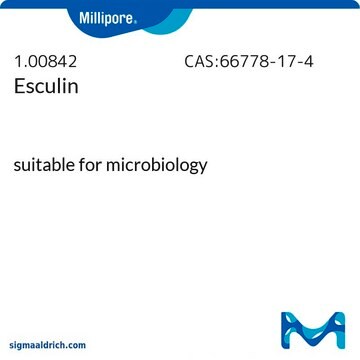1.09114
Potassium hydroxide solution
c(KOH) = 0.5 mol/l (0.5 N), in ethanol, reag. Ph. Eur., ready-to-use volumetric solution for titration in non-aqueous media, Titriplex®
Synonim(y):
Potassium hydroxide ethanol solution
About This Item
Polecane produkty
Nazwa produktu
Potassium hydroxide solution in ethanol, c(KOH) = 0.5 mol/l (0.5 N), Titripur®, reag. Ph. Eur.
agency
reag. Ph. Eur.
Poziom jakości
ciśnienie pary
59 hPa ( 20 °C)
linia produktu
Titripur®
Formularz
liquid
temp. samozapłonu
425 °C (ethanol)
jakość
Analyzed in our ISO 17025 accredited QC lab
granice wybuchowości
3.5-15.0 % (v/v) ethanol)
przydatność reakcji
reaction type: Acid-base reactions
stężenie
0.5 M
metody
titration: suitable
pH
14 (20 °C in H2O)
bp
78.3 °C/1013 hPa (ethanol)
mp
-114.5 °C (ethanol)
temp. przejścia
flash point 12 °C (ethanol)
gęstość
0.85 g/cm3 at 20 °C
temp. przechowywania
15-25°C
Zastosowanie
- Voltammetric Determination: Potassium hydroxide solution in ethanol is used in voltammetric determination of antioxidants in various matrices. A recent study demonstrated its application in the voltammetric determination of the antioxidant 2,6-di-tert-butyl-p-cresol (T501) in transformer oil using a graphite electrode. This method enhances the sensitivity and accuracy of antioxidant detection, crucial for ensuring the stability and performance of oils and other industrial fluids (Zhou et al., Analytical Letters, 2021).
Cechy i korzyści
This volumetric solution is analyzed by our calibration laboratory D-K-15185-01-00 which is accredited according to DIN EN ISO/IEC 17025 for analysis of amount-of-substance concentrations in volumetric solutions by DAkkS (Deutsche Akkreditierungsstelle - German National Accreditation Body). The accreditation certificate can be found at www.sigmaaldrich.com/ISO17025.
Opakowanie
Komentarz do analizy
Amount-of-substance concentration 0.4975 - 0.5025 mol/L
Measurement uncertainty ± 0.0015 mol/L
Traceability NIST SRM
The concentration is determined by volumetric titration and refers to 20°C.
The amount-of-substance concentration of this volumetric solution is traceable to a primary standard reference material (SRM) from the National Institute of Standards and Technology, Gaithersburg, USA (NIST SRM 350 benzoic acid) by means of volumetric standard benzoic acid (article number 1.02401), certified reference material according to ISO 17034, analyzed by our accredited calibration laboratory of Merck KGaA, Darmstadt, Germany according to DIN EN ISO/IEC 17025. The uncertainty is expressed as expanded measurement uncertainty with a coverage factor k=2 covering a confidence level of 95%.
Note: The titer is a correction factor to correct for variations of the volumetric solution, the titration equipment, the temperature and other laboratory conditions. For correct titration results it is recommended to determine a titer with the laboratory specific equipment and under laboratory specific conditions directly after opening a new bottle and at regular time intervals.
Informacje prawne
produkt powiązany
Hasło ostrzegawcze
Danger
Zwroty wskazujące rodzaj zagrożenia
Zwroty wskazujące środki ostrożności
Klasyfikacja zagrożeń
Eye Dam. 1 - Flam. Liq. 2 - Met. Corr. 1 - Skin Corr. 1B
Kod klasy składowania
3 - Flammable liquids
Klasa zagrożenia wodnego (WGK)
WGK 1
Temperatura zapłonu (°F)
53.6 °F - (ethanol)
Temperatura zapłonu (°C)
12 °C - (ethanol)
Certyfikaty analizy (CoA)
Poszukaj Certyfikaty analizy (CoA), wpisując numer partii/serii produktów. Numery serii i partii można znaleźć na etykiecie produktu po słowach „seria” lub „partia”.
Masz już ten produkt?
Dokumenty związane z niedawno zakupionymi produktami zostały zamieszczone w Bibliotece dokumentów.
Klienci oglądali również te produkty
Produkty
SmartChemicals enable wireless transfer of CoA data stored on an RFID tag on the consumable bottle to the titrator, reducing effort and chance for human error. Crucial data required for the application is transmitted safely, reliably and intelligently to the instrument.
Nasz zespół naukowców ma doświadczenie we wszystkich obszarach badań, w tym w naukach przyrodniczych, materiałoznawstwie, syntezie chemicznej, chromatografii, analityce i wielu innych dziedzinach.
Skontaktuj się z zespołem ds. pomocy technicznej









